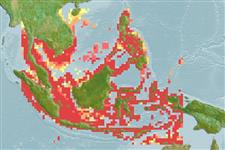Actinopterygii (ray-finned fishes) >
Perciformes (Perch-likes) >
Nemipteridae (Threadfin breams, Whiptail breams)
Etymology: Pentapodus: Greek, pente = five + Greek, pous = feet (Ref. 45335).
Environment / Climate / Range
Ecology
Marine; reef-associated; depth range 5 - 50 m (Ref. 90102). Tropical, preferred ?; 20°N - 12°S, 97°E - 135°E (Ref. 3810)
Western Central Pacific: Philippines, South China Sea, Singapore, and Indonesia.
Size / Weight / Age
Maturity: Lm ? range ? - ? cm
Max length : 18.0 cm SL male/unsexed; (Ref. 48635); common length : 15.0 cm SL male/unsexed; (Ref. 3810)
Dorsal
spines
(total): 10;
Dorsal
soft rays
(total): 9;
Anal
spines: 3;
Anal
soft rays: 7. Head scales reaching forward to between level of anterior margin of eyes and posterior nostrils. Suborbital naked. Lower limb of preopercle naked. Pelvic fins short, not reaching level of anus. Axillary scale present. Color: Pale brownish on back, lower part of body whitish. Presence of two bluish stripes across snout, first from middle of eye to tip of snout, second from upper lip to lower margin of eye. Top of snout dusky.
Found in silty coastal bays to deep muddy habitats offshore. Swims on open substrate adjacent to reefs, usually in small aggregations. Often with large bottom feeders such as stingrays to catch disturbed prey (Ref. 48635). Juveniles found close to reefs. Feeds on small crustaceans. Also taken by bamboo stake trap in Thailand. Used also in fish balls, fried and as duck food. Not much appreciated for food, and low priced.
Life cycle and mating behavior
Maturity | Reproduction | Spawning | Eggs | Fecundity | Larvae
Russell, B.C., 1990. FAO Species Catalogue. Vol. 12. Nemipterid fishes of the world. (Threadfin breams, whiptail breams, monocle breams, dwarf monocle breams, and coral breams). Family Nemipteridae. An annotated and illustrated catalogue of nemipterid species known to date. FAO Fish. Synop. 125(12):149p. Rome: FAO. (Ref. 3810)
IUCN Red List Status (Ref. 115185)
CITES (Ref. 94142)
Not Evaluated
Threat to humans
Harmless
Human uses
Fisheries: minor commercial
More information
Common namesSynonymsMetabolismPredatorsEcotoxicologyReproductionMaturitySpawningFecundityEggsEgg development
ReferencesAquacultureAquaculture profileStrainsGeneticsAllele frequenciesHeritabilityDiseasesProcessingMass conversion
Tools
Special reports
Download XML
Internet sources
Estimates of some properties based on models
Phylogenetic diversity index (Ref.
82805): PD
50 = 0.5002 [Uniqueness, from 0.5 = low to 2.0 = high].
Bayesian length-weight: a=0.01349 (0.00774 - 0.02350), b=2.99 (2.84 - 3.14), in cm Total Length, based on LWR estimates for this species & (Sub)family-body (Ref.
93245).
Trophic Level (Ref.
69278): 3.5 ±0.50 se; Based on food items.
Resilience (Ref.
69278): High, minimum population doubling time less than 15 months (Preliminary K or Fecundity.).
Vulnerability (Ref.
59153): Low vulnerability (23 of 100) .
